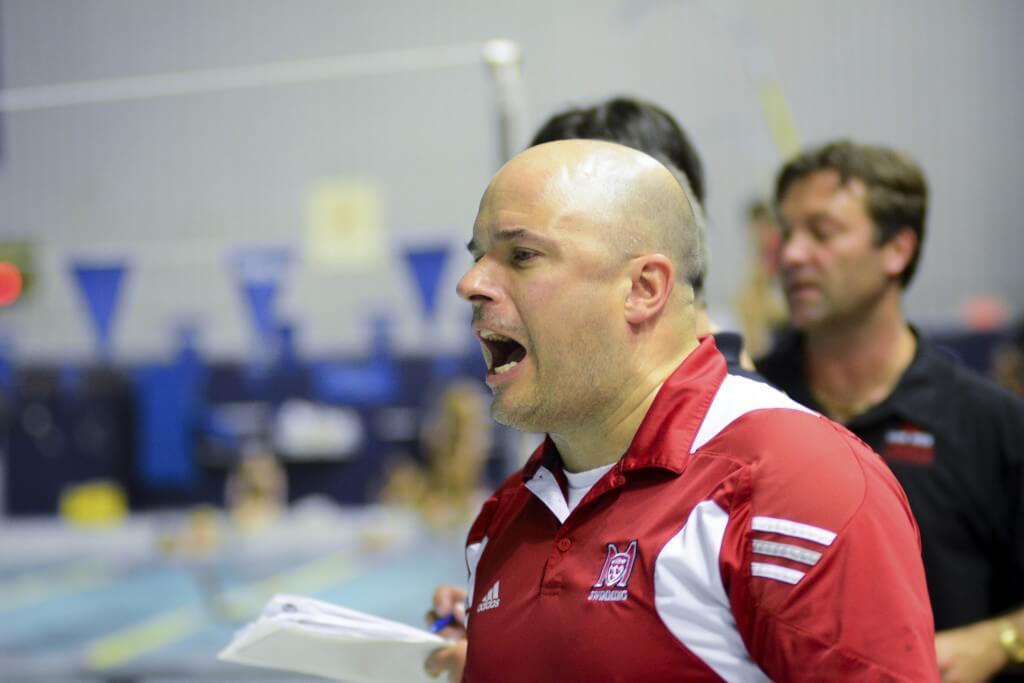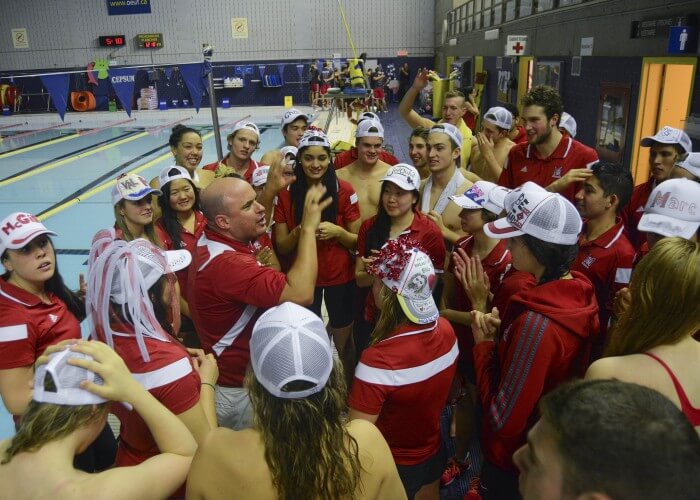How Peter Carpenter Balances Coaching Para and Varsity Swimming

By Matthew Grillo, Swimming World College Intern
Newly-appointed president of the Canadian Swimming Coaches & Teachers Association (CSCTA), Peter Carpenter, has finished up his sixth season as the head varsity coach of the men’s and women’s swim teams at McGill University. Under Carpenter’s guidance, his swimmers have amassed eight CIS (Canadian Interuniversity Sport) gold medals. Both the men’s and women’s teams have had top seven finishes at the CIS Championships since Carpenter took over at McGill.
Yet, throughout his tenure at McGill, Carpenter has had to manage his duties between varsity swimmers and para swimmers. He coached Valerie Grand’Maison to three Paralympic medals in 2012, where she won a gold medal and set a world record in the 200-meter individual medley in the S13 category.
He also recently led Sarah Mehain to the 2015 IPC World Championships where she will represent Canada. Prior to taking over at McGill, Carpenter was the head coach at the Pointe-Claire Swim Club where he coached numerous individual age group national champions.
Carpenter answered questions about how he balances and adjusts his practices for both para swimmers and varsity athletes.
MG: Are there any changes in the practices that you have to make for para swimmers?
PC: Now I have Sarah Mehain, who is in the S-7 class. She was born with cerebral palsy. She’s left side-dominant so her right side is considerably underdeveloped and weaker than her left side. There are adjustments that need to be made, but she needs all the same components of swimming as everybody else and then she needs more. She has a hard time with balance. Balancing in the water, even just floating on her stomach, she would tend to lean to one side because her left side is so much more developed and heavier than her right side.
Just floating in the water for her is a little bit trickier than for other people, so there’s certain technical things that we need to focus on more with her. But she needs to do the sprinting. She needs to do the aerobic work. She needs to load at times so all of those things are quite similar to any other athlete.
She trains at a three-quarter level, so she fits in very well with the group. If we’re doing 100s, she’ll do 75s. If we’re doing 25s, she might put on fins and she’ll fit in on the same interval. She really blends well with the group and she’s a part of the team, just like anybody else.
MG: What different approaches do you have to take when it comes to out-of-water training?
PC: Again where the balance comes into play. We have her do some sessions with the team on Tuesday and Thursday mornings, when we do dryland. At the beginning of the season, when we’re loading, she comes to those and she’ll make some adjustments. Some of the exercises she can’t do the same way. Overhead lifts she can’t do because her right arm is much smaller and shorter than her left arm. She could do it with dumbbells if she’s doing it separately, but she can’t do all the same exercises as everybody else.
One session per week she has a separate session. As a carded athlete, we have funds for her to be able to do that with Jason [Boivin], the strength and conditioning coach, so she can do very specific exercises so there’s certain things for her that we really need to do. We need to really focus on strengthening that right side, trying as much as possible to create balance and range of motion.
MG: How do you have to prepare for practice that involves para swimmers and able-bodied swimmers?
PC: Let’s say mid-season when I have 30 to 35 people in the water and I have to integrate her completely in to the practice. I will just go with the 75 percent approach, where she’s going to do 75 percent of the workout if we’re doing anything aerobic. Then if we’re doing something that’s high intensity and the interval is a little bit more open. I will have her follow along and she’ll actually do the same thing as everyone else. The intensity for her might not be as high.
She doesn’t train with the team every practice. She probably only trains 50 percent, maybe 60 percent of the time with the team and 40 percent of the time she trains on her own. When she’s on her own, I can get her stuff that’s a little bit more specific for her and write a workout that’s completely geared just towards her [with the] right intervals and give her the opportunity to really up her intensity.
When she’s doing something on the same interval as everybody else there’s no way that she can bring the same intensity as everyone else on the same frequency as everyone else. She’ll tighten up and that’s another issue with the cerebral palsy — her muscles will spasm. If that’s going to happen, and she’s going to start to swim with bad technique, I’ve got to hold her back. I’ve got to give her longer breaks, and when she trains on her own, I’m able to do that.
MG: Do you have to adjust taper in any way?
PC: The best taper we’ve had so far in the two years was the one we just had in April with her trials. I tapered her for two and a half weeks and they weren’t lifetime best times, but her April results were the best she’d ever been in April.
If she gets to the point where her central nervous system starts to shut down, she gets to that point much more quickly than the average swimmer, so I have to be very, very careful about that. Taper is really important for her, making sure she gets enough rest as she needs, but a lot of that comes down to actually her and making sure she gets the right amount of sleep.
Like anybody else, it really is the same. She really is no different. It would be nice to come up with all these drastically different things, but it’s all small adjustments that are needed in order to make things work.
MG: What have you learned from coaching para swimmers?
PC: With Sarah, it’s really understanding how the cerebral palsy effects her and it gives me a greater appreciation for how hard she’s had to work for everything that she’s achieved. Watching her day in and day out the level of focus she has to bring to make sure that she does the technique as well as she can do. If she shuts off her brain, it’s disaster time.
She really focuses. She asks me to not speak to her within 10 seconds of her leaving the wall because it’s going to confuse her and get her thinking about too many different things.
I can’t ask her to try to work on a six-beat kick and focus on her left arm entry. Forget about it. It’s one thing at a time. That approach is beneficial for a lot of athletes. I think that most athletes need to focus on one thing at a time.
It’s a very rare athlete that can really think about more than one thing at any given time as far as trying to make technical changes. It’s really gotten me to slow down and really focus on the athlete, and help them gain their focus. She’s really taught me that.





Well done Peter – keep up the good work – very rewarding. Tom
Well done – very rewarding for everyone involved – thanks